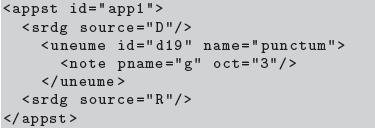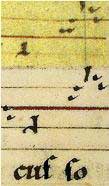TüBingen - Phase 1
Phase 1 seeks to develop a data format appropriate to the general demands of critical music editing as well as to the pecularities of Hildegard's music and its transmission.
The data format should allow for
- representation of variant source readings including the
- critical commentary as well as the
- encoding of neume forms
Comparing existing formats
Comparing three already existing XML-based data formats which seem appropriate to fulfill the task (MusicXML, MEI, NeumesXML) we came to the conclusion that currently none of them fits all demands:
-
MusicXML by Michael Good/Recordare is probably today the most wide-spread XML-based music format
and connects via interfaces to numerous music notation software as f. ex. FINALE.
But this format was mainly concieved as an exchange format for music notation and not for scholarly editions. This is why it is not possible as to now to encode variant source readings in one single file or to represent early music notation as f.ex. neumes. -
MEI (Music Endocing Initiative) developed by Perry Roland closely following the
TEI (Text Encoding Initiative)
from the beginning aimed to enable the representation of scholarly critical editions of music.
Therefore this format is well equipped with means to encode variant souce readings in a single file and to represent the critical commentary.
Currently the format doesn't support the encoding of early music notation, but permits to include extensions to do this. -
NeumesXML by Louis W. G. Barton was developed to provide a unified format for
the encoding of neumes.
The format therfore supports the representation of numerous neume families as well as of the meta-data for liturgical manuscripts.
Its "universal" approach to represent all exisiting neume families in one single format and the lack of connection to other XML-formats bring this format into danger of a "splendid isolation".
Furthermore NeumesXML doesn't support the encoding of variant readings in one single file.
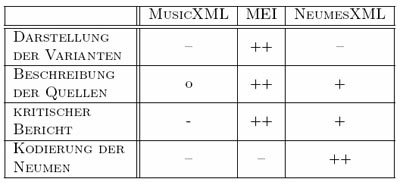 |
|
Extending MEI by meiNeumes
As a conclusion of comparing existing XML-formats we decided that the best solution for project TüBingen would be to extend MEI by a module supporting the encoding of neumes.
MEI already largely supports the representation of variant source readings and the encoding of the critical commentary in a single file.
These features are independant of the musical repertory chosen. The necessary extension is thus reduced to the encoding of the neumes in the Hildegard manuscripts.
In collaboration with Perry Roland we developed the module meiNeumes which will be included into the newest version of MEI.
It supports the encoding of neumes and several other special notational features and is activated by
 |
|
Encoding examples
We present here several selected features of the extension of MEI by meiNeumes chosing as an example Hildegard's antiphone O splendidissima gemma [Codex Dendermonde]:
 |
|
-
Clefs and staff lines
-
Encoding the c- and f-clef which occur at the same time and where the f-clef can also appear in the shape of a dot:

-
Encoding the number of staff lines. In most cases the scribes use four lines adding as a fifth line
the text line of the stave above.
The example encodes a staff with 5 lines using a c-clef on the fourth line and an f-clef in shape of a dot on the second line:

-
Changing of clefs within a song:

-
Encoding the c- and f-clef which occur at the same time and where the f-clef can also appear in the shape of a dot:
-
Locating a song within the manuscript
-
Encoding folio and line on the page:

-
Encoding folio and line on the page:
-
Encoding neumes
-
The syllable as the element containing the neumes corresponds to the medieval notion
of musicalizing a text.
The example encodes the red O-initial of the first syllable and the neume form attached to it, a Porrectus, as well as the pitches.
The encoding also shows the important difference between a graphically uninterrupted written neume (uneume) and a graphically interrupted written neume (ineume).
In this case this is an uninterrupted written Porrectus:
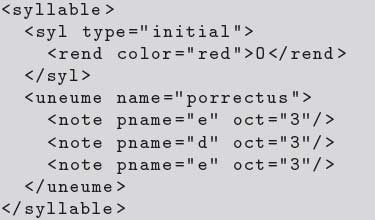
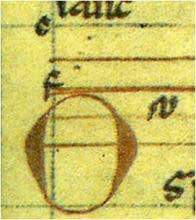
-
Encoding a graphically interrupted Scandicus, made up of single-tone neumes:
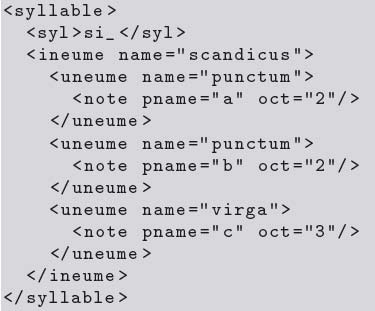
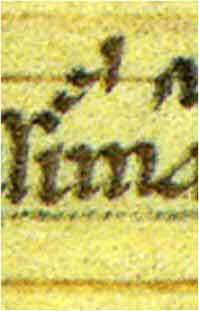
-
Graphical variants of neume signs indicating a special performance practice which still is
not totally clear are encoded using the attribute form.
These are: liquescent neume forms, the rhombic form of the Punctum used in the Hildegard manuscripts sometimes in place of the sickle-shaped form, or as in the following example the modification of a Pes into a Quilisma-Pes:


-
The syllable as the element containing the neumes corresponds to the medieval notion
of musicalizing a text.
It is activated by
 |
|
-
Annotations
-
A sequence of neume signs is in certain cases open to interpretation by the editor.
Using the element annot the sequence of neumes in the following example is intepretated as a 3-tone Quilisma-Scandicus subtripuncits and the fact that this is an interpretation by the editor is marked:
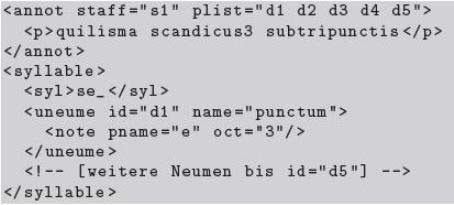
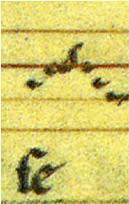
-
A sequence of neume signs is in certain cases open to interpretation by the editor.
-
The encoding of variant readings is supported by the element appst.
In the follwing example the additional Punctum G within the syllable so- in Codex Dendermonde in contrast to Codex R is encoded as well as the appropriate annotation:
